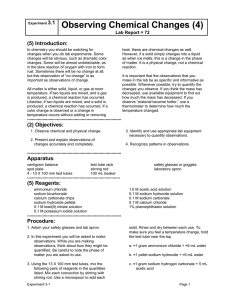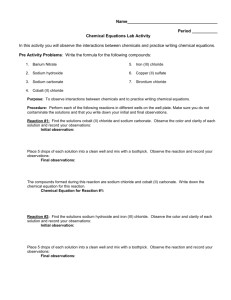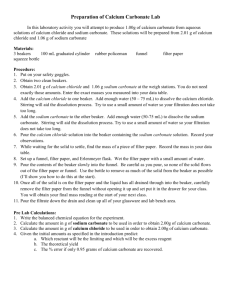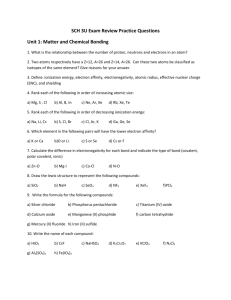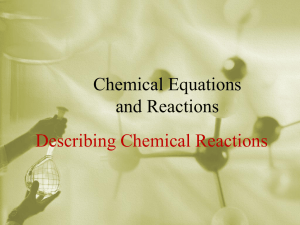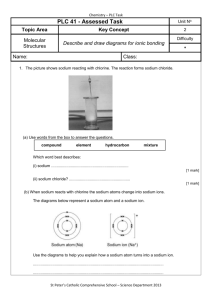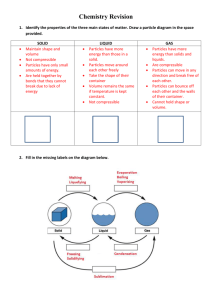6.1 Explore Gas Prop..
advertisement
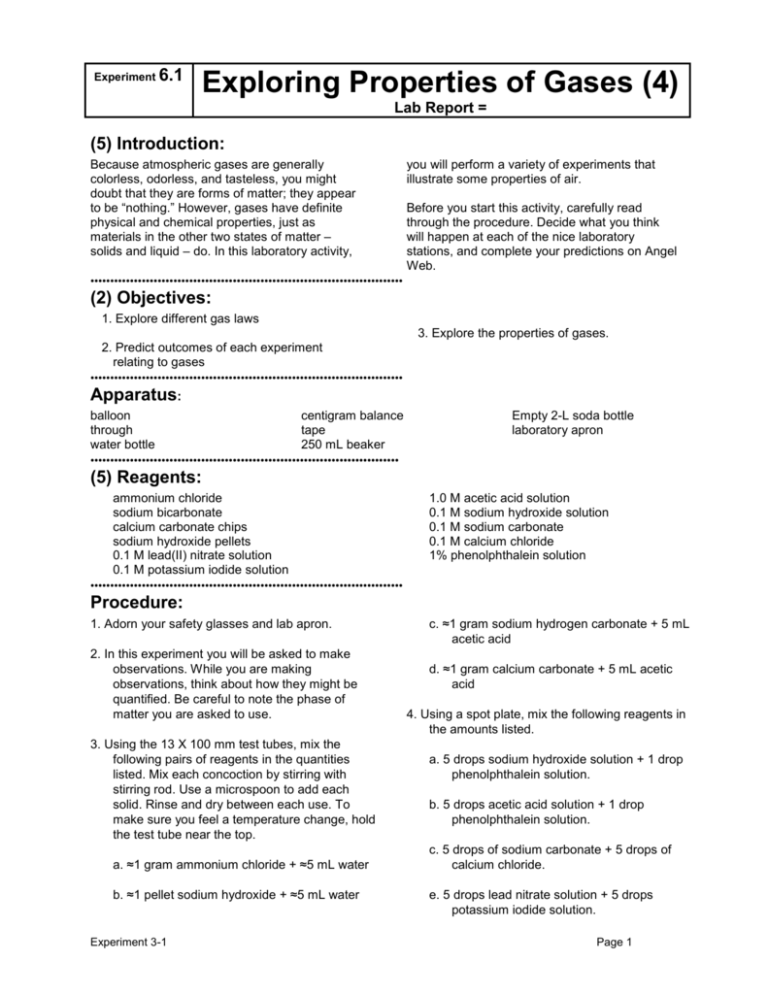
Experiment 6.1 Exploring Properties of Gases (4) Lab Report = (5) Introduction: Because atmospheric gases are generally colorless, odorless, and tasteless, you might doubt that they are forms of matter; they appear to be “nothing.” However, gases have definite physical and chemical properties, just as materials in the other two states of matter – solids and liquid – do. In this laboratory activity, you will perform a variety of experiments that illustrate some properties of air. Before you start this activity, carefully read through the procedure. Decide what you think will happen at each of the nice laboratory stations, and complete your predictions on Angel Web. ••••••••••••••••••••••••••••••••••••••••••••••••••••••••••••••••••••••••••••••• (2) Objectives: 1. Explore different gas laws 3. Explore the properties of gases. 2. Predict outcomes of each experiment relating to gases ••••••••••••••••••••••••••••••••••••••••••••••••••••••••••••••••••••••••••••••• Apparatus: balloon through water bottle centigram balance tape 250 mL beaker Empty 2-L soda bottle laboratory apron •••••••••••••••••••••••••••••••••••••••••••••••••••••••••••••••••••••••••••••• (5) Reagents: ammonium chloride sodium bicarbonate calcium carbonate chips sodium hydroxide pellets 0.1 M lead(II) nitrate solution 0.1 M potassium iodide solution 1.0 M acetic acid solution 0.1 M sodium hydroxide solution 0.1 M sodium carbonate 0.1 M calcium chloride 1% phenolphthalein solution ••••••••••••••••••••••••••••••••••••••••••••••••••••••••••••••••••••••••••••••• Procedure: 1. Adorn your safety glasses and lab apron. 2. In this experiment you will be asked to make observations. While you are making observations, think about how they might be quantified. Be careful to note the phase of matter you are asked to use. 3. Using the 13 X 100 mm test tubes, mix the following pairs of reagents in the quantities listed. Mix each concoction by stirring with stirring rod. Use a microspoon to add each solid. Rinse and dry between each use. To make sure you feel a temperature change, hold the test tube near the top. a. ≈1 gram ammonium chloride + ≈5 mL water b. ≈1 pellet sodium hydroxide + ≈5 mL water Experiment 3-1 c. ≈1 gram sodium hydrogen carbonate + 5 mL acetic acid d. ≈1 gram calcium carbonate + 5 mL acetic acid 4. Using a spot plate, mix the following reagents in the amounts listed. a. 5 drops sodium hydroxide solution + 1 drop phenolphthalein solution. b. 5 drops acetic acid solution + 1 drop phenolphthalein solution. c. 5 drops of sodium carbonate + 5 drops of calcium chloride. e. 5 drops lead nitrate solution + 5 drops potassium iodide solution. Page 1 5. Record all observations on the data table. 7. Clean up all materials and wash your hands thoroughly. 6. If in doubt on any part, repeat that part. ••••••••••••••••••••••••••••••••••••••••••••••••••••••••••••••••••••••••••••••• Data and Observations: (20) (10) (10) Data Table Chemicals Used ammonium chloride and water Sodium hydroxide pellets and water sodium hydrogen carbonate and acetic acid Calcium carbonate and acetic acid Stamp for 4 tubes................. sodium hydroxide and phenolphthalein acetic acid and phenolphthalein Sodium carbonate + Calcium chloride Lead(II) nitrate + potassium iodide Stamp for 5 wells.................. Observations ••••••••••••••••••••••••••••••••••••••••••••••••••••••••••••••••••••••••••••••• (18) Analysis and Conclusions: (8) 1. Describe in clear terms how each step of the procedure could be repeated to collect quantified data. a. ammonium chloride + water b. sodium hydroxide and water c. sodium hydrogen carbonate and acetic acid d. calcium carbonate and acetic acid e. sodium hydroxide and phenolphthalein f. acetic acid and phenolphthalein g. sodium carbonate + calcium chloride h. lead(II) nitrate + potassium iodide (3) 2. Describe any temperature changes you observed. (2) 3. Describe any color changes you observed. (2) 4. Which combinations produced a gas? (2) 5. Which combinations produced a precipitate? (1) 6. Which combinations resulted in no reaction? ••••••••••••••••••••••••••••••••••••••••••••••••••••••••••••••••••••••••••••••• (18) Synthesis: 1. Based on your observations, predict the results of mixing the following pairs of chemicals. Explain why you are making a particular prediction. If you cannot make a particular prediction, tell why. Experiment 3-1 (4) a. magnesium carbonate + acetic acid i. prediction ii. explanation Page 2 (4) b. ammonium hydroxide + phenolphthalein i. prediction ii. explanation (2) 2. Suppose you wanted to collect and find the mass of a gas produced in a chemical reaction. How would you do it? (4) c. lead nitrate + sodium chloride i. prediction ii. explanation Extra Credit: (10) (4) d. hydrochloric acid + sodium hydroxide i. prediction ii. explanation Write and balance the complete reaction between sodium hydrogen carbonate and acetic acid, calcium carbonate and acetic acid, sodium carbonate and calcium chloride, and lead(II) nitrate and potassium iodide. Experiment 3-1 Page 3

